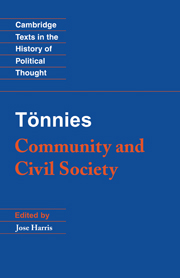Book contents
- Frontmatter
- Contents
- Acknowledgements
- General introduction
- Chronology of Tönnies's life and career
- A note on the texts and further reading
- A note on translation
- Glossary
- COMMUNITY AND CIVIL SOCIETY
- Book One A general classification of key ideas
- Book Two Natural will and rational will
- Book Three The sociological basis of natural law
- Appendix: Conclusions and future prospects
- Index
- CAMBRIDGE TEXTS IN THE HISTORY OF POLITICAL THOUGHT
A note on translation
Published online by Cambridge University Press: 05 June 2012
- Frontmatter
- Contents
- Acknowledgements
- General introduction
- Chronology of Tönnies's life and career
- A note on the texts and further reading
- A note on translation
- Glossary
- COMMUNITY AND CIVIL SOCIETY
- Book One A general classification of key ideas
- Book Two Natural will and rational will
- Book Three The sociological basis of natural law
- Appendix: Conclusions and future prospects
- Index
- CAMBRIDGE TEXTS IN THE HISTORY OF POLITICAL THOUGHT
Summary
Even a hundred years ago Tönnies's friend, Friedrich Paulsen, complained of his ‘horrible sentences’, while to many modern Germans he is ‘the Great Unreadable’ because his constructions require a command of German grammar that has largely fallen into disuse. Tönnies's style favours the traditional periodic German sentence, long, convoluted, with many subordinate clauses branching off one another. This is possible in German because the language has genders and inflections, so that it is clear to which word a relative pronoun is referring. This feature of his writing we have not attempted to retain, and the long sentences have been broken up in accordance with English usage. Another of Tönnies's preferences was for constructions which balance two halves of an argument, e.g. both … and; not only … but also; on the one hand … on the other hand; x stands to a as y stands to b; and so on. In many cases this feature has had to be greatly simplified in order to avoid confusion in English.
Tönnies used many archaic words and grammatical structures, influenced no doubt by older authors from his wide reading and by his own Schleswigian background. Although the 1887 edition was published in Roman print, the 1912 edition was printed in the old Gothic style, as were all subsequent editions before that of 1979. Similarly, many Latinate spellings of German words employed in 1887 were ‘Germanised’ in the 1912 edition.
- Type
- Chapter
- Information
- Tönnies: Community and Civil Society , pp. xxxviii - xlPublisher: Cambridge University PressPrint publication year: 2001



